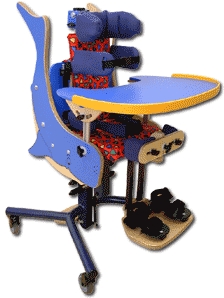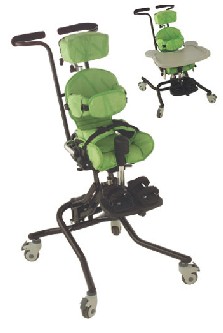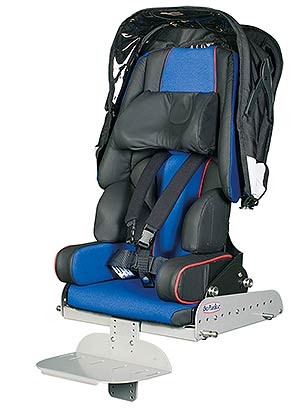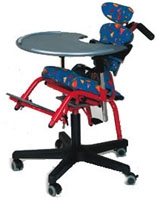More Details
Whale is suitable for almost all children with special seating needs. It offers conventional sitting (90-90-90), reclined sitting, tilt in space and long leg sitting.
Footplate and Sandals
The footplate support is height adjustable via a lever at the front.
Each sandal foot support can be adjusted for width, moved forwards or backwards and rotated. This is completed by loosening a wing nut underneath each sandal.
Knee cups
The knee cups should be removed when transferring the child in and out of the Whale chair. Loosening the wing nut below the seat base will allow the kneecup unit to be removed. When replacing the unit, this adjustment also allows for some alteration in depth.
The wing nuts at the front of each kneecup can be loosened to enable the individual kneecup to be adjusted for depth or be rotated to provide support either on the inside or outside of the knee area.
The central wing nut on the unit allows for height adjustment of both kneecups together.
The manufacturer states that the kneecup should rest over the knee joint itself.
Seat Depth Adjustment
Seat depth may be altered via two wing nuts underneath and moved forwards and backwards into the required position and tightened in place.
Hip Support Pads
The width and height of the hip support pads can be adjusted by loosening the yellow wing nuts on the backrest, and be retightened once in the required position.
Pelvic Strap
Once seating the child in the chair, the manufacturer states the buckle in the centre of the strap should be clipped together to secure the child.
Strap length is altered by opening the swiss locks beneath the back of the seat on each side, and pulling the two straps until the correct length is achieved. Each side should be even so the buckle remains in the middle of the child. The swiss locks are flipped downwards to secure in place.
Chest Strap and Thoracic Support Pads
The length of the chest strap can be adjusted by opening the swiss lock on either side of the thoracic supports, adjusting the length and closing the swiss locks. The padded section of the chest strap should be in the middle of the chest.
The width and height of the thoracic supports may be adjusted via yellow wing nuts on the back of the chair.
Armrests
The armrests are adjustable in height and angle. The grade scale on the armrest carrier provides a guide to get both of the armrests at the same height. This enables the tray to be secured in place.
Tray
The tray secures on each of the armrests by locating the small pins underneath the tray into one of the holes in the armrests. In addition, the blue button under the tray one each side needs to be turned to secure it in place.
The tray can be fitted closer to or further away from the child dependent on which hole the pin is located into.
Backrest Angle
The backrest angle can be altered by loosening two blue wing nuts behind the backrest and tightening in place once the desired angle is achieved.
Shoulder Support Pad
This is a support between the backrest and the headrest.
It is removable.
It is height adjustable by a black wing nut at the back of the pad.
Headrest
The headrest is adjustable in height, depth (forwards or backwards) and angle.
The headrest is a Multi Grip headrest. This features a series of adjustable joints to shape the headrest into the desired position.
Tilt In Space
The chair is able to be tilted from a level plane backwards up to 25 degrees.
Tilt is adjusted by lifting a lever underneath the seat, and releasing the lever will lock it in position.
Chair Height Adjustment
A pedal at the rear of the chair needs to be depressed to raise or lower the seat.
To lower the seat hold the handle bars and depress the pedal, guiding the chair to the desired height. If the weight of the child is insufficient for the chair to lower, additional pressure can be placed to the top of the hip pads.
To raise the seat, depress the pedal and the chair will raise automatically. If this does not happen, upward pressure can be placed to the handle bars.
When the chair is empty, to lower press the pedal and apply downward pressure on the centre of the seat.



 subscribers
subscribers 






